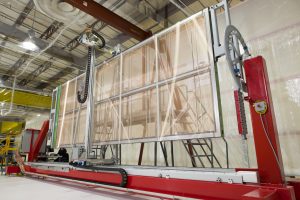How can you build 150 particle detector assemblies in less than three years if the completion of one assembly takes almost two months?

An anode plane assembly module for the ProtoDUNE detector is under construction at the Physical Sciences Lab at the University of Wisconsin. Photo: Reidar Hahn
This is one of the big questions that scientists and engineers working on the international Deep Underground Neutrino Experiment have to answer to meet the ambitious goal of starting data taking in 2026. And the National Science Foundation just awarded a $1.6 million grant to four U.S. universities to develop the plan.
“Building an experiment of this scale requires years of research and development,” said Denise Caldwell, director of NSF’s Division of Physics. “We are pleased that this award will enable NSF collaborators to contribute to the planning of this truly international effort.”
While this is an NSF planning award for DUNE, the foundation has a long history of investments in major particle physics experiments, including research to uncover the mysteries of neutrinos. NSF is the primary funding source of the IceCube Neutrino Observatory, located at the South Pole. The IceCube collaboration recently announced the first evidence of a source of high-energy cosmic neutrinos, giving us a more complete understanding of the universe.
The NSF grant for DUNE expands the foundation’s pioneering and significant investments in liquid-argon neutrino detectors and physics, including early investments in the ArgoNeuT, MicroBooNE and Short-Baseline Near Detector experiments.
DUNE, supported by the U.S. Department of Energy Office of Science and hosted by the DOE’s Fermilab, will use four gigantic particle detector modules filled with a total of 70,000 tons of liquid argon to look for tracks created by neutrinos to learn more about these elusive particles and the role they play in the universe. A crucial building block of these modules are large, rectangular frames with four layers of wires on each side, called anode plane assemblies. Each APA comprises 24,000 meters of wire, wound in straight lines to record the signals created by neutrino collisions in liquid argon.
Over the past two years, DUNE collaborators have built six of these APAs, each about 6 meters long and 2.3 meters wide, for a prototype detector the size of a two-story building, assembled at CERN. The final DUNE detectors, to be installed a mile underground at the Sanford Underground Research Facility in South Dakota, each will be 20 times larger. DUNE will need 300 APAs: half of them are expected to be built by a consortium of universities at Daresbury Laboratory in the UK, which already manufactured modules for the prototype at CERN; and the other half is expected to be built at facilities in the United States.
Now with support from the NSF, scientists and engineers from the University of Chicago, Yale, Syracuse and the Physical Sciences Laboratory at the University of Wisconsin are taking the lead to finalize the design of the APAs for DUNE and figure out how a broad consortium of U.S. universities—including many more institutions than the four receiving the initial NSF grant—could collectively build 150 APAs and ship them to South Dakota for installation underground.
“Once we have finalized the design and production plan, we will submit a proposal from a broad consortium of US universities to build the 150 APAs,” said University of Chicago’s Ed Blucher, who is the lead investigator on the NSF grant and co-spokesperson of the DUNE collaboration. “It will secure a leading role for NSF-supported university groups in constructing and ultimately in extracting physics from DUNE.”
The four institutions have extensive expertise in the design and production of wire planes for liquid-argon neutrino detectors, starting more than a decade ago.
“Now it is the technology of choice for many neutrino experiments,” said Bonnie Fleming, who served as the founding spokesperson for the ArgoNeuT and MicroBooNE experiments. “At Yale’s Wright Lab, we are winding wire planes for the Short-Baseline Near Detector at Fermilab. This effort is led by Syracuse and funded by the NSF, and students and postdocs from collaborating institutions are engaged in the process.”
The four institutions also have facilities that are big enough to set up the large assembly lines for the wiring and mass production of the APAs. In fact, the Physical Sciences Laboratory built four of the six APAs installed in the first DUNE prototype detector at CERN.
“There are not many institutions that have facilities with enough floor space for this kind of work,” Blucher said. “The NSF grant allows us to figure out how to put the APA production facilities into existing buildings, how to run those factories, how to integrate students and postdocs into the project, and how to plan for the work flow.”
So how do you produce 150 APAs in less than three years?
“Setting up multiple assembly lines and increasing the efficiency of winding each APA are part of the answer,” Blucher explained. “Ultimately, the assembly of each APA must be faster while maintaining superb quality control.”



